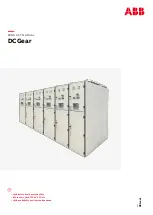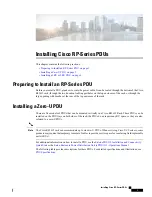
—
2 Receiving, handling and storage
2.1 Introduction
This chapter describes the procedures for the
receipt, handling and storage of panels and is
intended to support the customer in the verification
of receipt and in the protection of the products
before installation.
2.2 Receiving
For transportation purposes the panel are usually
packed and shipped in multiple sections, each
comprising up to a maximum of seven
compartments (refer to the layout of the order
for the exact composition of the sections).
With the panel are shipped the materials necessary
accessories for mounting and for installation,
except for the foundation beams that are normally
installed by the customer.
Switches and related accessories are packed and
shipped separately.
Upon receipt of:
•
Make sure that the packaging is intact and
free from damage during shipping. If not
noted on the delivery note "PACKAGE DAMAGED,
THE POSSIBILITY OF DAMAGES TO THE
MATERIALS CONTAINED" doing counter sign
the note to the carrier and immediately warning
the ABB sales office about the damage occurred
in transit. Keep the damaged material for the
carrier's inspection. Do not proceed if you do
not open the package in the presence of the
carrier
•
In the absence of any obvious damage remove
the packaging and check that you have every
item shown on the waybill
•
Check there is no damage to the products
•
In case of lack of materials or damage to
contact ABB
2.3 Handling
Warning
Heavy weight
Can cause death, serious injury or
property damage.
Obtain services of a qualified rigger
prior to hoisting the circuit breaker to
assure adequate safety margins in
hoisting equipment and procedures to
avoid damages.
6
DCGear
P R O D U C T M A N U A L
—
Fig.1 Handling systems
The handling and lifting DCGear panel, after
receiving them, must be done with care and
avoid subjecting the same to abnormal stress,
violent shocks, etc..
The lifting of the panel, still packed, must be
performed with the use of a crane and cables
of adequate section appropriately positioned
(fig.1.1). The weights of the individual conveyor
sections are indicated on the waybill.
The lifting of the panel without packaging should,
possibly, be performed with the use of a crane
and of appropriate cables passed through the
holes provided on the lifting crosspieces (fig.1.2).
When a crane is not available, the panel can be
moved with the use of suitably spaced rollers
positioned under the base (fig. 1.3).
•
The supporting surface of the rollers is flat
•
The rollers are parallel to the front of the panel
•
The amount of rollers is adequate to prevent
deformation of the structure
Avoid using forklift trucks to transport that could
cause localized deformation and permanent
structure of the panel.
2.4 Storage
Wherever possible, the panel must be installed
immediately in its final position.
In the event that it is necessary to provide a
storage for some time prior to installation, it is
advisable to store the equipment in its original
packaging.
2.4.1 Environmental conditions of storage
2.4.1.1 Storage in original packaging
If possible store the panel in their original
packaging.
Packing in wooden crates or cardboard.
Store in an environment protected from the
weather, covered, well-ventilated area with
temperatures between 0°C and +40°C, with a
maximum relative humidity of 60% with occasional
spikes up to 90%, without rapid changes in
temperature, order to avoid condensation.
Maximum storage time: four months.
Packed with case in phenolic plywood and
laminated barrier.
Although it is possible a storage outdoor for a
short period, it is advisable to store under a roof
with temperatures between-5°C and+ 55°C.
This type of packaging allows storage of up to
a year without need for special controls or
maintenance.
2.4.1.2 Storage off from its original packaging
Store this equipment in a confined space, clean,
dry and free from dust and corrosive atmospheric
agents. The panel must be carefully covered and
protected with a polyethylene film of minimum
thickness 0.2 mm. The temperature should be
between -20°C to+ 50°C. To avoid condensation
and corrosion, the environment needs to be
heated and capable of ensuring the absence of
sudden and severe temperature changes.
—
Fig.1






































